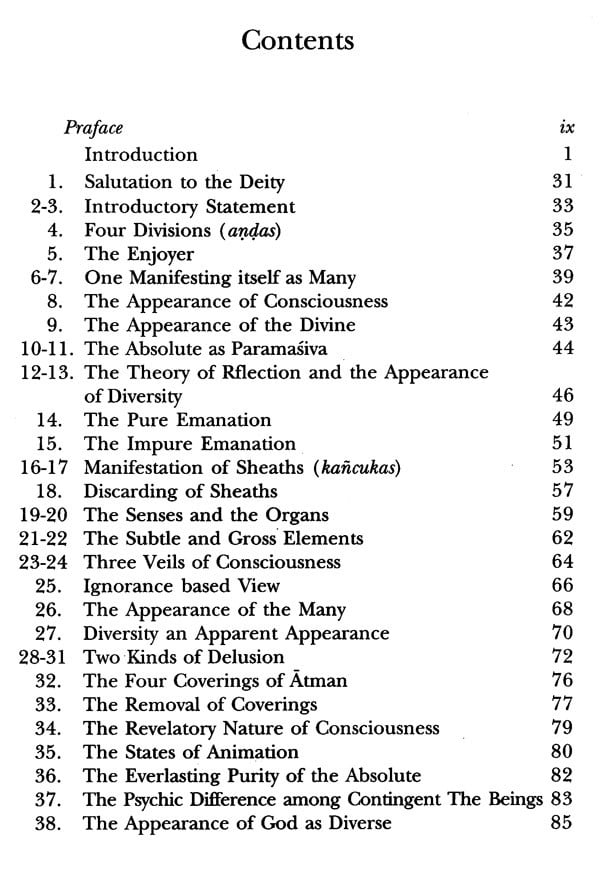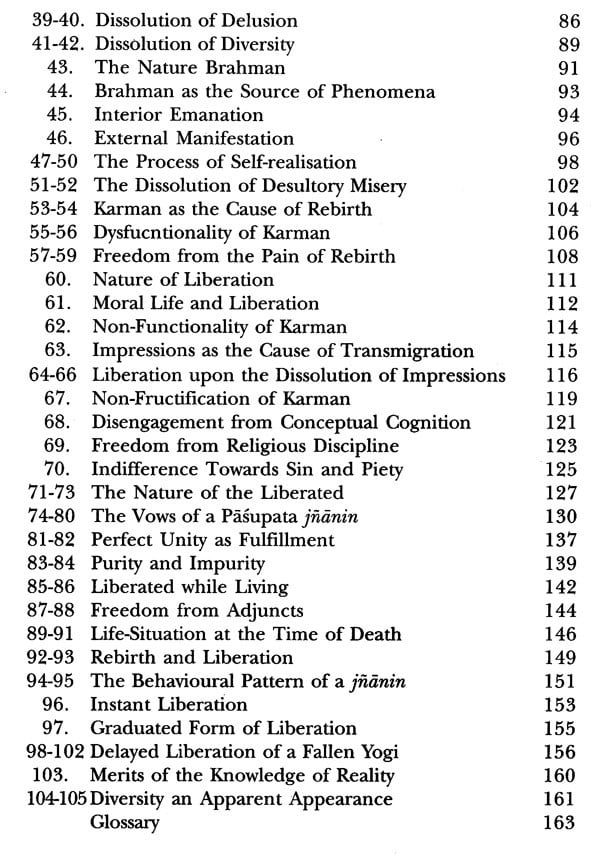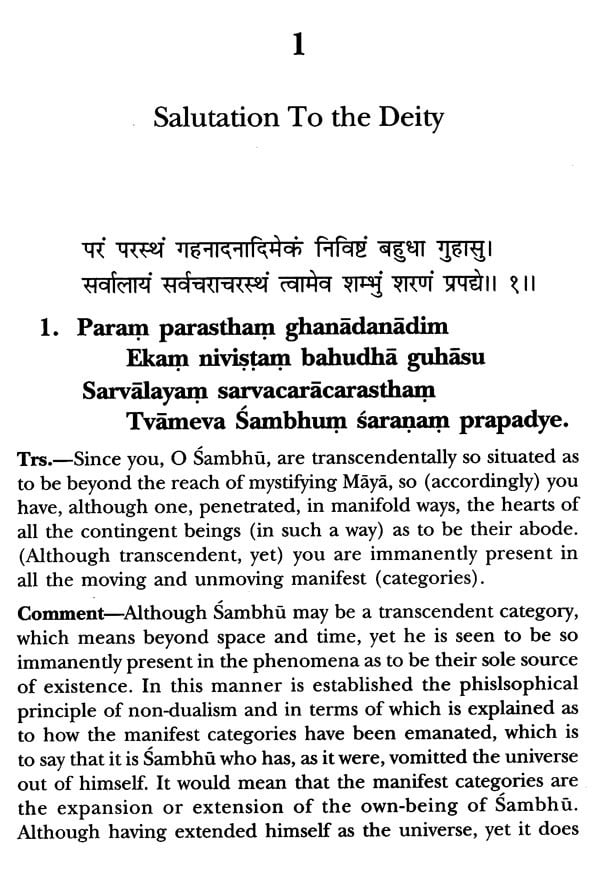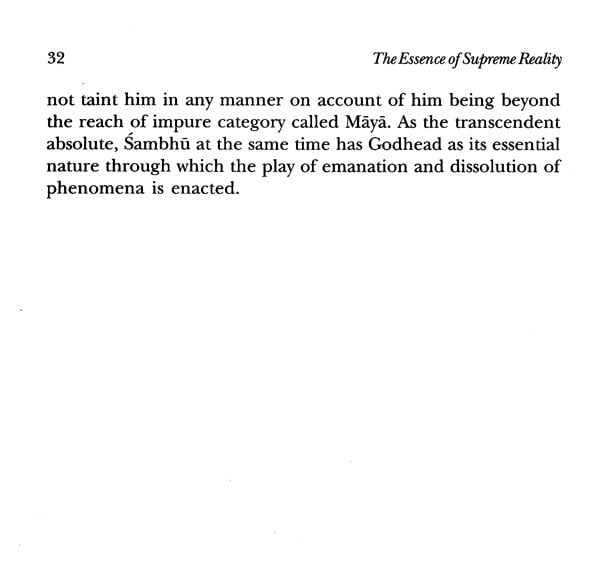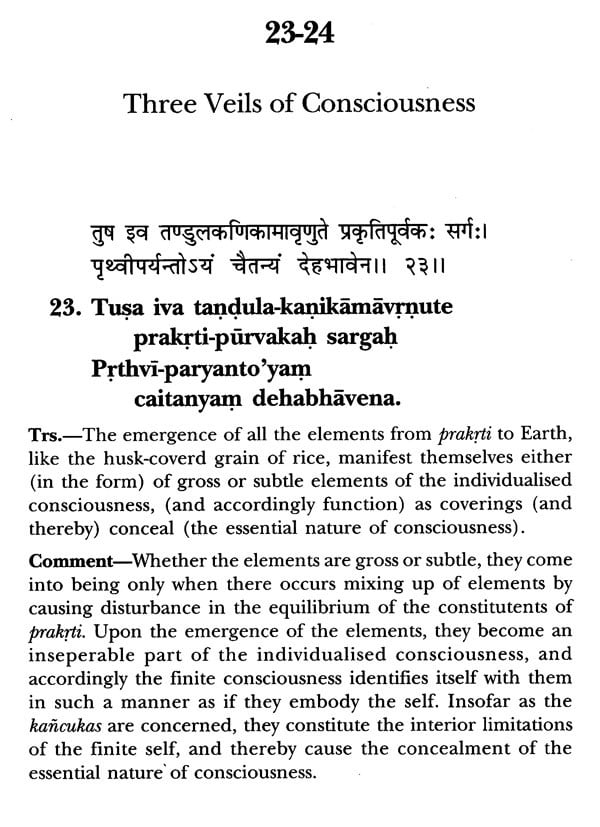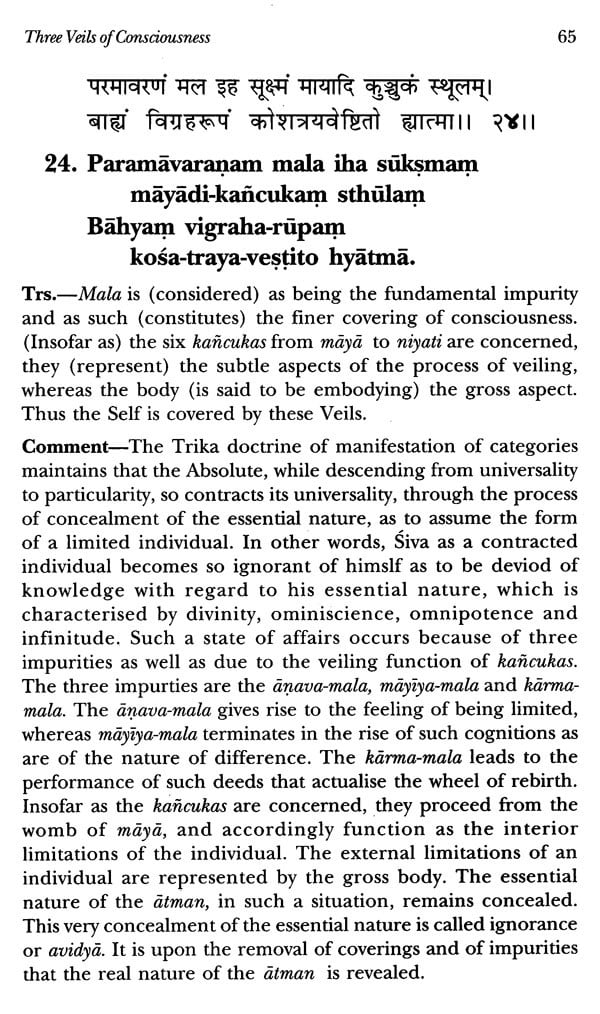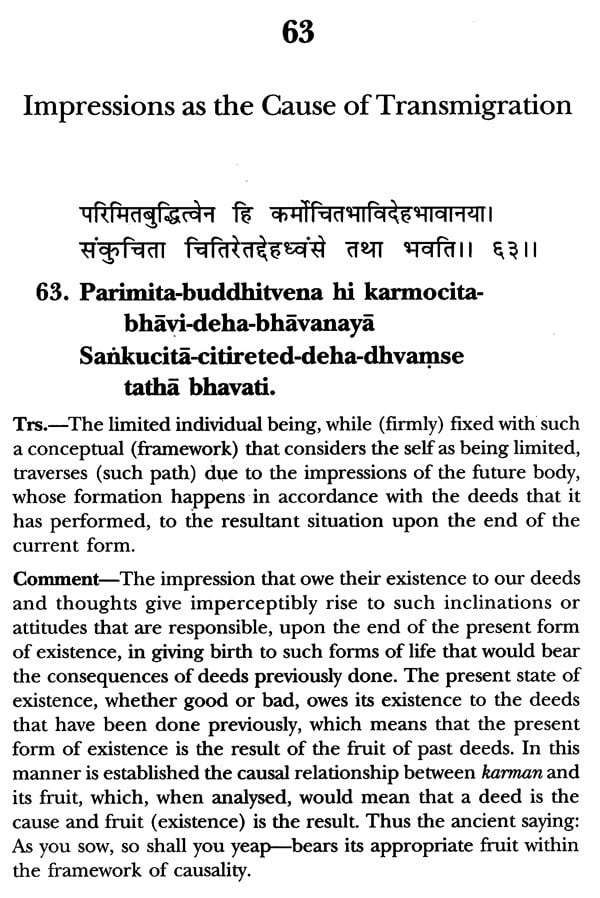
The Essence of Supreme Reality Or The Paramarthasara of Abhinavagupta
Book Specification
| Item Code: | NCZ247 |
| Author: | Moti Lal Pandit |
| Publisher: | MUNSHIRAM MANOHARLAL PUBLISHERS PVT LTD |
| Language: | Sanskrit Text With Transliteration and English Translation |
| Edition: | 2021 |
| ISBN: | 9788121513555 |
| Pages: | 173 |
| Cover: | HARDCOVER |
| Other Details | 9.00 X 6.00 inches |
| Weight | 330 gm |
Book Description
The Paramarthasara of Abhinavagupta is composed in such an easy style as would enable the reader to comprehend the most abstruse doctrines of Trika Shaivism in a manner that would be free from conceptual confusion and logical inconsistency. The text explains profoundly such philosophical and theological themes as would necessarily constitute the core or heart of any serious discussion. The text attempts at clarifying the following doctrinal principles of Trika Shaivism: cosmology (1-9); ontology (10-13); emanation of objectivity (14-22); bondage and liberation (23-33); the metaphysical status of phenomenon (34-38); nature of knowledge (39-46); self-realisation (47-67); the spiritual status of a yogin after self-realisation (68-88); the theory of transformation (89-93); the behavioural pattern of a liberated yogi (94- 96); the graduated process of liberation.
Moti Lal Pandit, trained as a theologian and linguist, has been engaged in Indological research for last fifty years. He has published articles as well as books on a vast range of subjects. Initially he began his research in Vedic religion and philosophy. Gradually he shifted his attention towards Buddhism, and, as a result of this shift, he has been successful in publishing a number of books on Buddhist philosophy and history. For the last several years, however, he has been fully engaged in the study of Trika Shaivism of Kashmir. Some of his publications are: Vedic Hinduism; Essentials of Buddhist Thought; Philosophy of the Upanishads; Samkara's Concept of Reality; Did Marx Kill God; Buddhism in Perspective; Being as Becoming; Towards Transcendence; Sunyata: The Essence of Mahayana Spirituality; Buddhism: A Religion of Salvation; Encounter with Buddhism; The Buddhist Theory of Knowledge and Reality; Transcendence and Negation; The Trika Shaivism of Kashmir; The Disclosure of Being; An Introduction to the Philosophy of Trika Shaivism; The Philophical and Practical Aspects Kasmira Shaivism, and From Dualism to Non-Dualism.
Till the beginning of last century hardly anyone knew that there exists a well-developed philosophical school of thought known as Kashmir Shaivism. With the establishment of Kashmir Sanskrit Series Texts in the beginning of last century, a number of important Sanskrit texts on Shaivism were published, and accordingly people at large came to know about the existence of Kashmir Shaivism. For this act of establishing the Research Center as well as the undertaking of publication of important texts on Kashmir Shaivism, we have to be grateful to Swami Ramaji who inspired the then Maharaja Pratap Singh in such a manner as would result in the establishment of this important institution. The Maharaja Pratap Singh also deserves our humble gratitude for initiating a programme in terms of which revival of Kashmir Shaivism would become a possibility. It is these two noble souls who initially made the revival of Kashmir Shaivism a possible project. It is around this time that Grierson also published the Sayings of Lalla, thereby facilitating the passage for the emergence of knowledge concerning Kashmir Shaivism that would have universal audience.
Insofar as the term Kashmir Shaivism is concerned, it owes its existence to a book, called Kashmir Shaivism, written by J.C. Chaterjee who was the first Superintendent of the Research Institute established by the then Maharaja of Jammu and Kashmir. The traditional nomenclatures by which Kashmir Shaivism is known are Paradvaitavada, Svatantrayavada, Rahasyavada, etc. Also in the Sarvadarsana-samgrha of Madhvacarya Kashmir Shaivism is simply refereed to as the Pratyabhijnadarsana. All these different nomenclatures have been brought by Abhinavagupta under the rubric of Trika. Thus Kashmir Shaivism is known either as Kashmir Shaivism or as Trika Shaivism. Also it was during the middle of the last century that two prominent scholars, namely, Gopinatha Kaviraja and K.C. Pandey, made Kashmir Shaivism known to a wider audience through their scholarly publications. Apart these two scholars, Swami Laksamanjoo also has played an important role in the revival of Kashmir Shaivism. Many Europen and Indian scholars learnt the most secret aspects of Shaivism from him. Also mention must be made of Dr. Baljinath Pandit, who composed many original works like, for example, Svatantrya-darpana as well as the commentary on the Sivasutras. During the last part of the last century many European scholars have published mumerous texts, and accordingly the essential message of Kashmir Shaivism has reached the public at large. We must not forget to mention the name of Shri Jaideva Singh who, through his many publications, has popularised the teaching of Trika among the masses. He has translated some of the most important texts into English like the Sivasutras, Spandakarikas, Pratyabhijnahrdayam, etc. However still the large corpus of Sanskrit texts have neither been edited properly nor published. Lot of effort has to be made to delve deeper into the mysterious world of Kashmir Shaivism.
One of the reasons as to why Kashmir Shaivism has remained a closed book to people outside Kasmhir could be the very physical features of the valley. The high mountains and the difficult terrain must have proved to be one of the major obstructions in the spread of the metaphysical doctrines of Kashmir Shaivism. The second reason could be the harsh Muslim rule, which not only caused destruction to the ancient heritage, but created such obstacles as would become difficult to engage in knowledge-oriented pursuits. As a result of these obstacles nothing much was written except few exceptions. It is important to note at this point that our Gurus, viz., Purohitas, were responsible, to a large extent, in preserving the Sanskrit language as well as the Sharada script. Had they not secretly preserved the valuable manuscripts, we would have been completely deprived of Sanskrit language, Sharada script as well as the treasure of manuscripts. Even in the midst of this strenuous effort towards the preservation of our cultural heritage, lot of valuable literary and philosophical texts have been lost forever. We know about these lost texts only through quotations and references. Many important works of Somananda, Utpaladeva and Abhinavagupta are no more available. We must, thus, express our gratitude to our Purohitas for preserving, under harsh conditions, the rich heritage of which we all are proud. The harshness of Muslim rule can be gauged from the fact that from Yogaraja to Sahib Kaula, which is to say approximately four hundred years, the number of thinkers that the community produced is muniscule. The last Shaiva thinker of some significance was Harabhatta Sastri, who composed a valuable commentary on the Pancasatavi. This explanation tells us as to why Kashmir Shaivism, even in the valley, had to go underground, which means that it was not possible in such conditions to engage in the activity of spreading the message of Trika Shaivism to public at large. The other reason that could be seen to be responsible in prevenenting the spread of knowledge with regard to Kashmir Shaivism could be the dearth of such text that would introduce the beginner to the rich mysteries of Trika. In the case of the Advaita Vedanta such situation does not prevail. They are fortunate in having a plethora of such texts which have been made as the basis of teachings for the beginners. Trika Shaivism, however, lacks such texts that could be used as tools for teaching the beginners. This lacuna is being, to some extent, bridged by the Paramarthasara. May be it is with such an intention that Abhinavagupta re-casted and re-edited the Vaisnava Paramarthasara of Patanjali in such a manner as would serve his purpose and in terms of which the doctrines of the Trika could be formulated for the beginners. The other text that has been written for the beginners is the Parapravesaka or The Entrance into the Absolute of Ksemaraja. Apart from these two manograpphs nothing worthwhile exits for the beginners.
Since most people do not have the knowledge of Sanskrit language, so the need for an English translation arose. The translation has been made in such manner as would make it easier to approach the text with an easeful mind. I hope and pray for its success. As to whethr I have succeeded in my mission or not would be known only when it is read by people for whom it is written. At this point I must express my gratitude to my granddaughter, Maitri Pandit, for helping me in editing the text. Lastly. I must express my thanks to the publishers, namely, Munshiram Manoharlal, for undertaking the publication of the Paramarthasara.
Early to the Paramarthasara of Abhinavagupta, there existed a Vaisnava text of the same name whose authorship has been ascribed to Adisesa. This Adisesa, with the passage of time, has been identified with Patanjali, who is considered to be the incarnation of a thousand-headed snake deity, known as Sesanaga. As to why Patanjali has been identified with a thousand-headed snake needs some explanation. Such identification may have occurred due to the preponderance of the Naga cult at the time when the pre-Abhinavagupta Paramarthasara was being composed. The other reason that could be envisaged would be that the author of the text is seen to be possessing such power of thinking as would a thousand-headed snake. It would indicate that the author's intelligence was as sharp as is the edge of a rozor.
There is a belief making rounds that the earlier Paramarthasara represented Samkhya system of thought, and this commonly-held belief owes its existence to Yogaraja, the commentator of the Paramarthasar of Abhinavagupta. There is no doubt that the text possesses some elements of the Samkhya system, but when studied in its entirety, it becomes clear that the text is a Vaisnava work. As such it is Vaisnava theism that dominates the thought of the Paramarthasara of Sesa.
There are many works or texts of various schools of thought that contain some elements of Samkhya thinking-and that does not mean that the text pertains to the Samkhya system. The Samkhya being the earliest philosophical system, it is but natural to see its influence prevalent everywhere, and thus the Samkhya philosophical terms are found to be present as much in the Vaisnavism of Mahabharata as much as they can be located in the Vedantic theism of the Upanisads. Even though the Samkhya elements may have deeply influenced the thinking of Sesa, yet it cannot be denied that the work is definitely a Vaisnava in character and thinking. Although Vaisnava in its orientation and content, the philosophical direction of the text embodies such an ontlogy as would be totally representing the metaphysical absolutism. The Vaisnavism of Sesa/Patanjali differs redicaly from the Vaisnavism that is more inclined towards the mysticism of myth than reason. Insofar as Patanjali's Vaisnavism is concerned, it is more metaphysical and rational. He develops the superstructure of metaphysical absolutism on sound logical principles.
Whether it be Ramanuja or Vallabha, the Vaisnava thinkers have a tendency to so wrap their philosophical thinking as to obliterate the difference that exists between reason and emotion. The qualified non-dualism of Ramanuja or the Visuddhadvaita of Vallabha may be having a sound philosophical reasoning as its base, yet, on account of intensive devotionalism, it ultimately takes shelter in such emotional forms of thinking as would erode its metaphysical thinking. Insofar as Patanjali is concerned, he sticks to his philosophical worldview like a rock. The non-dualism of Patanjali is as theistic as would enable it to avoid the pitfalls of vivartavdda of Samkara. It is, therefore, reasonable to assert that the most ancient Vaisnava form of theistic absolutism is to be found in the Paramarthasara of Patanjali.
It is the Paramarthasara of Adisesa/Patanjali that became the basis for the text that Abhinavagupta composed. The style, content and the method of presentation of Adisesa seems to have so much attracted Abhinavagupta as would incline him to adopt this, after necessary editing, as his own. Abhinava made such necessary changes in the original Paramarthasar which he deemed fit for the purpose of making a good presentation for the framework of the Trika Saivism of Kashmir. The intention of adopting this text as his own was simply to present, in simple and lucid language, the philosophical and theological thinking of Trika in such a manner as would be appropriate for the beginner. While re-casting the text, Abhinava avoids discussion on such philosophical topics that are contentious. The purpose is to present Trika Saivism in such a manner as would be simple and shorn of philosophical rivalry or antagonism. The simplicity of presentation indicates that the use of dry logic evidently becomes unnecessary. Sophisticated logical discussion is to be found in such works as, for example, the Sivadrsti of Somananda or the Isvarapratyabhijina-karika of Utpalacarya. The Paramarthasara is composed in such a manner as would encompass, in a diction that is simple, the entirety of Trika Saivism. It is the best available text insofar as the beginner is concerned. One who studies this text with a focused mind will be able to undertake the study of such philosophically sophisticated works as the ,Sivadrsti.
**Contents and Sample Pages**
